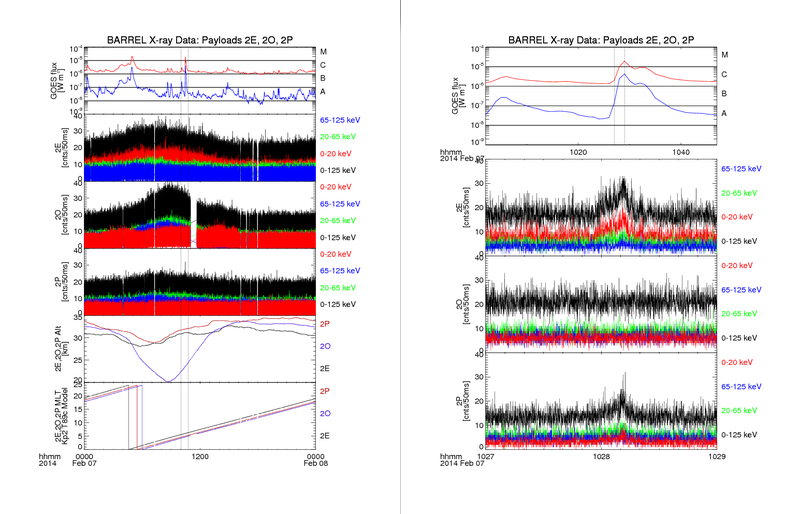BARREL Balloon Observations and History
From RHESSI Wiki
m |
|||
| Line 74: | Line 74: | ||
]] | ]] | ||
| - | The instrumentation on each BARREL payload consists of a simple | + | The instrumentation on each BARREL payload consists of a simple isotropically sensitive |
[https://en.wikipedia.org/wiki/Sodium_iodide sodium iodide] | [https://en.wikipedia.org/wiki/Sodium_iodide sodium iodide] | ||
[https://en.wikipedia.org/wiki/Scintillation_detector scintillation counter]. | [https://en.wikipedia.org/wiki/Scintillation_detector scintillation counter]. | ||
Revision as of 22:48, 17 February 2014
| Nugget | |
|---|---|
| Number: | 219 |
| 1st Author: | Greg Bowers |
| 2nd Author: | Alexa Halford |
| Published: | February 17, 2014 |
| Next Nugget: | TBD |
| Previous Nugget: | Instantaneous Flare Properties |
| List all | |
Contents |
Introduction
Solar hard X-rays and gamma-rays were discovered in the middle of the last century via balloon-borne instruments [Ref. 1]. By modern naming convention, we'd call their flare SOL1958-03-20T13:05, but it preceded any useful soft X-ray observations and so there is no GOES classification of the event. Peterson & Winckler do report the simultaneous occurrence of a "magnetic crotchet," as also detected in the case of the Carrington flare in 1859. Such a geomagnetic effect clearly indicates the presence of strong solar soft X-ray emission along with the high-energy radiations discovered from the balloon.
In this Nugget we report recent balloon-borne observations from multiple balloons of the BARREL expedition to the Antarctic. Robyn MIllan of Dartmouth College is the lead scientist of this ambitious experiment. As with the original Peterson-Winckler experiment, BARREL wasn't designed to study solar flares, but their signals come through loud and clear anyway. BARREL's instrumentation allows it to study the precipitation of relativistic electrons from the Earth's Van Allen Belts, which indeed may share some kinds of plasma physics with what happens in a solar flare.
How BARREL Works
A stream of small balloons circles the Antarctic continent, following the vortex winds at high altitudes in the polar regions. At any one time several balloons can fly simultaneously, strung out around the Antarctic according to their time of launch. Power comes from solar cells, and full-time communication via the Iridium satellite network and an automated connection to a real-time webpage, allowing the ground-based scientists to follow along. For radiation-belt studies, multi-point measurements mean much better science. A rather fine video describes the basic program better than we can here. We do show a pretty picture here in Figure 1, though, taken at the launch of a BARREL balloon from the South African Antarctic station SANAE.

The instrumentation on each BARREL payload consists of a simple isotropically sensitive sodium iodide scintillation counter. This responds well to the gamma-rays and hard X-rays resulting from bremsstrahlung as the expected relativistic electrons undergo atomic collisions in the upper atmosphere. The time variations reveal the presence of interesting phenomena, and the detector records their spectra over a wide energy range The solar gamma-rays and hard X-rays result from similar physics, but with the collisions taking place in the solar atmosphere instead of the Earth's.
BARREL Solar Observations
The BARREL detectors respond to many things, since they are above the atmosphere. The full list would include many sources of cosmic X-rays, the Sun as illustrated here, the Van Allen Belts by design, and radiation from the Earth's atmosphere. For each of these components, the others would be termed "background radiation" and just reduce the quality of the observation - but that is how astrophysics usually works!
Figure 2 shows the BARREL responses to the modest M-class flare SOL2014-02-07T10:29. Note that BARREL payload "2O" missed out, but note also (the lower left panels) that it was at low altitude. This results in severe extinction of the incident solar radiation, especially since the Sun is low on the horizon even at high noon at such latitudes - if up at all.

Why is this interesting? The BARREL view of solar flares will likely have important consequences, depending upon the development of solar activity. Many balloon flights, starting in the 1950's [Ref. 1] have made numerous discoveries with more primitive instruments. The multi-detector observation is interesting too, although we certainly expect the solar X-ray intensity to be uniform on the small angular scale subtended by Antarctica at the Sun. That is because of calibration. At some point we will have sensitive and well-calibrated sensors in deep space, on large angular scales, and we fully expect to be able to measure interesting anisotropies in the flare emissions.
Conclusions
BARREL reminds us of the origins of solar high-energy astrophysics (soft X-rays, hard X-rays, gamma rays, "solar cosmic rays"), and we hope that analysis of many events can be organized. Last year's campaign netted 1,380 hours of observation - likely many solar flares - and this year's is still in progress at time of writing.
References
| RHESSI Nugget Date | 17 February 2014 + |
| RHESSI Nugget First Author | Greg Bowers + |
| RHESSI Nugget Index | 219 + |
| RHESSI Nugget Second Author | Alexa Halford + |